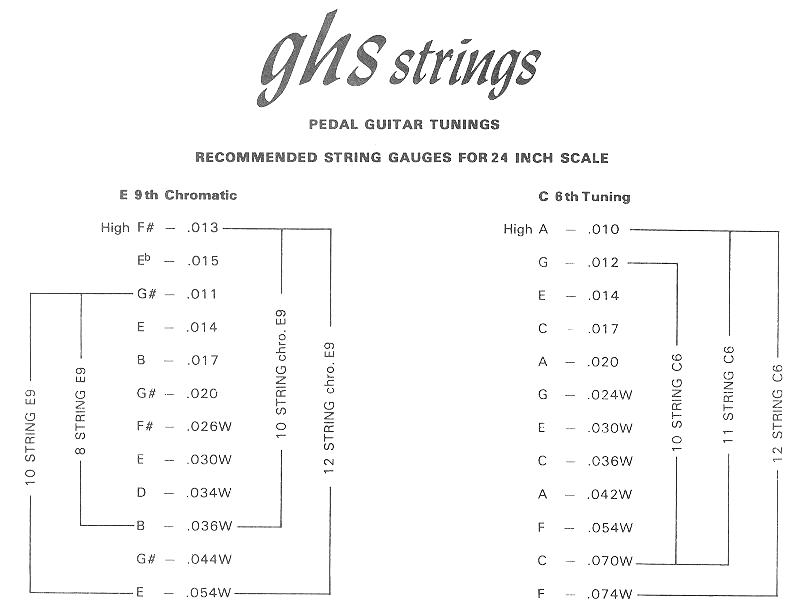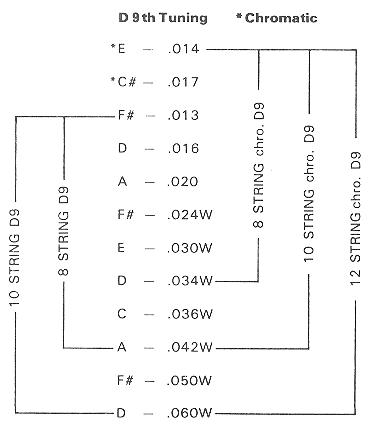Steel Guitar String Gauges
Pedal &
Non Pedal
I recommend buying strings from
(very reasonable prices)...
www.juststrings.com
8 string lap steel semi-flat wound sets (C6th,
E13th,
E7th,
A6th)
The chart below is from GHS
strings, but I have no personal
preference in the brand of strings that I use on my musical instruments.


Proper String Gauge Chart
Maroon =
Standard Guitar |
Pine Green = C6th Lap
Steel |
Midnight Blue = Tuning
Overlap
| Pitch |
Gauge Range |
Description of String |
|
A |
.009 to .011 |
|
|
G#/Ab |
.010 to .011 |
|
|
G |
.011 to .012 |
|
|
F#/Gb |
.012 to .013 |
|
|
F |
.013 to .015 |
|
|
E |
.013 to .015 |
C6th 1st String; Standard
Guitar High E |
|
D#/Eb |
.014 to .016 |
|
|
D |
.015 to .017 |
|
|
C#/Db |
.016 to .018 |
|
|
C |
.016 to .018 |
C6th 2nd String, Middle C |
|
B |
.017 to .019 |
Standard Guitar B String |
|
Bb/A# |
.018 to .020 |
|
|
A |
.020* to .022* |
C6th 3rd String |
|
G#/Ab |
.024* to .026* |
|
|
G |
.024* to .026* |
C6th 4th String; Standard
Guitar G String |
|
F#/Gb |
.024w to .026w |
|
|
F |
.026w to .030w |
|
|
E |
.028w to .032w |
C6th 5th String |
|
D#/Eb |
.028w to .032w |
|
|
D |
.032w to .036w |
Standard Guitar D String |
|
C#/Db |
.034w to .038w |
|
|
C |
.034w to .038w |
C6th 6th String |
|
B |
.034w to .038w |
|
|
Bb/A# |
.034w to .038w |
|
|
A |
.040w to .044w |
Standard Guitar A String |
|
G#/Ab |
.042w to .046w |
|
|
G |
.044w to .048w |
|
|
F#/Gb |
.048w to .052w |
|
|
F |
.052w to .056w |
|
|
E |
.054w to .058w |
C6th 6th String; Standard
Guitar Low E |
|
D#/Eb |
.056w to .060w |
|
|
D |
.060w to .064w |
|
|
C#/Db |
.060w to .068w |
|
|
C |
.064w to .068w |
|
|
B |
.064w to .068w |
|
|
Bb/A# |
.068w to .072w |
|
|
A |
.068w to .072w |
|
* Where indicated by
an asterisk symbol, either
wound or plain strings can be used. I prefer a wounded string when given an
option. I also prefer semi-flats on all my non-pedal steel guitars. Flat
wound strings aren't as vibrant and responsive as round wounds, so
semi-flats are a nice compromise in between. But truthfully, if you've never
tried flat wounds, why not give it a try to see for yourself? They are nice,
I admit, and I still use them on my Jerry Byrd 8 string short-scale Frypan
(simply because they last forever and I've never felt like changing them.
They aren't as bad as you might think. They are a bit more muffled, but it's
not real noticeable. Round wounds are more noisy, obviously, when sliding
the bar. The top strings on ALL GUITARS are plain steel anyway, so when
considering round or flat wound, we're only talking about the bottom few
strings of your steel guitar.
I think the semi-flat wounds are real nice.
Example String
Gauges for Common Tunings
| C6th |
A6th |
E7th |
C6th |
C13th |
| E |
.014 |
E |
.014 |
E |
.014 |
G |
.012 |
E |
.014 |
| C |
.017 |
C# |
.017 |
B |
.018 |
E |
.014 |
C |
.017 |
| A |
.021 |
A |
.021 |
G# |
.024w |
C |
.017 |
A |
.021 |
| G |
.024w |
F# |
.026w |
E |
.030w |
A |
.021 |
G |
.024w |
| E |
.030w |
E |
.030w |
D |
.034w |
G |
.024w |
E |
.030w |
| C |
.036w |
C# |
.036w |
B |
.038w |
E |
.030w |
C |
.036w |
| |
|
A |
.042w |
G# |
.046w |
C |
.036w |
Bb |
.042w |
| |
|
F# |
.052w |
E |
.056w |
A |
.042w |
C |
.068w |
Dunlop .018"
Mini Brass Finger Picks (Amazon.com)
(I love these mini brass picks! I use
the .0225 gauge, which are a bit stiffer to bend. I like the shiny brass look.
I have always hated larger picks that don't fit my fingers. These picks are
perfect! Very nice!)
Helpful Information About
Strings
Beloved steel guitar legend, Jerry Byrd (1920-2005), said he preferred to use a
.016" string for his top E string. Jerry liked the tone obtained from using a
slightly thicker gauge string. It is normally recommended to use between a .013"
to a .015" gauge string for a high E note. This works fine for me unless I try
to raise that .016" string to a G note, which I sometimes like on top, as Bobby
Ingano uses. I have to use no thicker than .014" for a G note. It all boils down
to personal preference on string sizes.
Also, on my Pro II Sho-Bud pedal steel
guitar, I use a .022w (wound) for the 6th string on the E9th neck. I learned
this from Lloyd Green, who says he likes the sound that a .022" wound string
produces. However, the wound string doesn't work with my split-tuner on my
Rittenberry S-10. If memory serves me correct, the string won't go low enough.
So I have to use a plain .022" like Tommy White uses on his guitar. I love both
of my steels, but I wanted to mention this quirk about using a plain or wound on
the 6th string (i.e., G#). So I use a wound string when I can.
Nickel strings last longer, not as
susceptible to rust from humidity, but stainless steel is brighter (which is my
preference). Many steel artists prefer stainless steel strings on the E9th, and
nickel on the C6th neck. I tend to agree, but I can happily use either of them.
I find that adjusting the amplifier can usually give me the tone I'm looking
for. Everything from the size of the room, guitar make, pickup type, amplifier
type and make, to the way I feel at any given moment, affects the sound that I
perceive to hear.
As a general rule, a thicker string gauge
will produce a sweeter tone. This is why Jerry Byrd used a .016" instead of a
.013" to .015" on his top E string. When I first bought my Pro-II Sho-Bud in the
1990's, the guy who owned it didn't know how to use the knee levers or pedals.
So he put these really heavy gauge strings on the steel and played it like a
non-pedal steel. I still remember the day I went to buy it from him in Richmond,
Indiana. He was playing Steel Guitar Rag at a private lodge that he
belonged to. I think that may have been the only song he knew, but he could
really play it well!
So when I bought it from him, he didn't
tell me about the strings (I don't think he knew to be honest) and I played it
as it was, with the heavy gauge strings on it. Wow, what a beautiful sound!!!
However, my pedals were very tight to press down. I was relatively new to
playing steel guitar and didn't know any better. When I decided to go ahead and
change my strings, the pedals played like butter. What a big difference!
Unfortunately, that sweet awesome tone was also GONE! So you may desire to do a
little experimenting on your steel guitar. If your pedals are too tight, you
might want to go a little thinner on the string gauges (or vise versa). Of
course, by doing so you will need to make some adjustments to your raises and
lowers, with the hex nut tuners.
The legendary Jimmy Day (1934-1999)
recorded his famous Steel & Strings album by detuning his Sho-Bud down to
a D9th instead of an E9th. Wow, what a difference it made in the tone!
Beautiful, in a word! I once tried to do this on my pedal steel, but
stopped, because I would have needed to make some mechanical alterations to
accommodate the lower tuning. But if you tinker with the string gauges, and have
the time and patience, it is well worth the effort.
That is one of the reasons why Herb
Remington's (1926-2018) recordings are so sweet, because he used the A6th
instead of the C6th, which is three half tones lower in pitch. It really makes a
big difference in the sweetness of the tone. I have always enjoyed the A6th
tuning.
Granted, the industry has advanced
incredibly over the past 50 years and everything is set the way it is for a good
reason. Proper string gauges are intended to provide the best playability,
performance and fun for the musicians. I'm simply sharing a little known fact
with you, that





